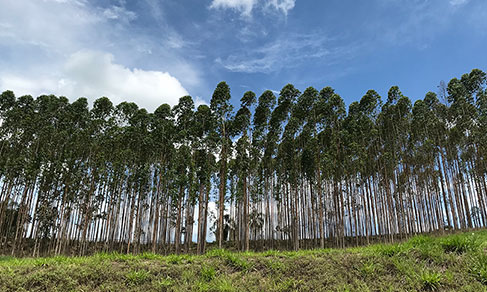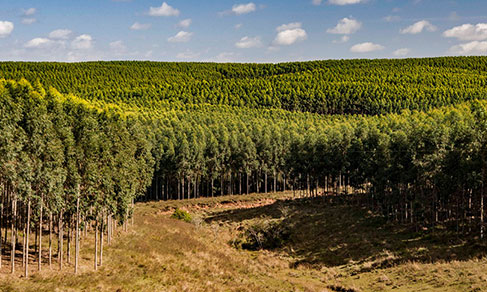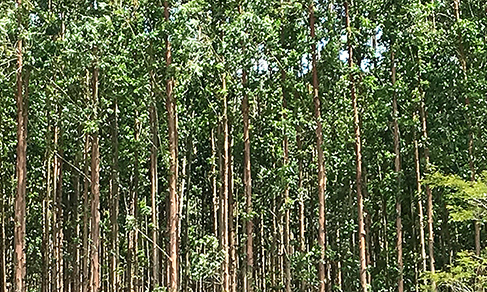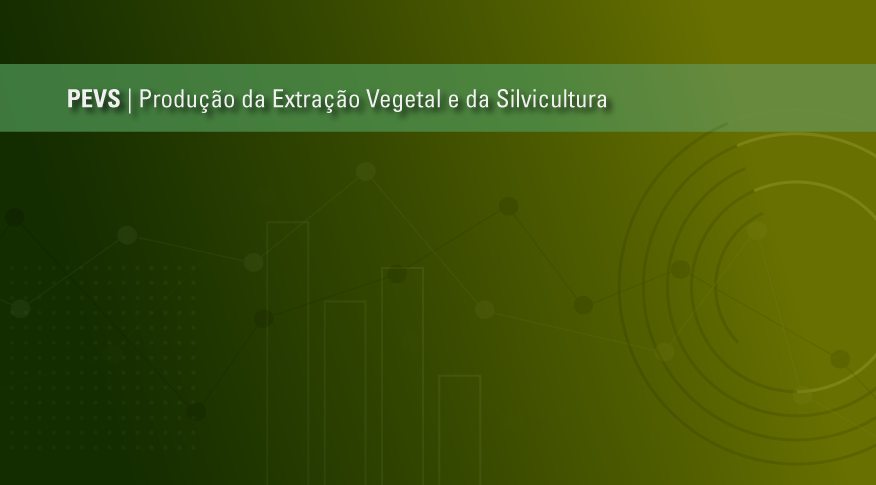Nossos serviços estão apresentando instabilidade no momento. Algumas informações podem não estar disponíveis.
PEVS - Forestry Activities
About - 2023
The Survey of Forestry Activities - PEVS is the main source of statistics on the systematic monitoring of exploitation of forestry resources all over the national territory.
With the release of this fact sheet, the IBGE presents general commentaries on the main results of PEVS relative to 2023, regarding the amount and value of production resulting from the exploitation of native vegetation resources nd of areas of planted forests. Wild crop harvesting encompasses information on the gathering of food, rubber, wax, fibers, wood, oil seeds and others, as well as on the production of pine knots, felled trees and logged wood from native Brazilian pine. Regarding silviculture, there is information on black wattle barks, eucalyptus leaves and resins, as well as on the production of charcoal, firewood and logged wood, according to the major forest species planted for exploitation (eucalyptus, pine and others). The analysis focuses on the relative share of these sectors in the whole forestry industry, making references to the biggest producers in Brazil.
The PEVS fact sheets are also available in printed version. The technical notes are released separately and can be viewed online, only, on this same page. They provide general information about the data collection methodology and the definition of variables investigated in the survey.
The IBGE also presents the complete table plan of the survey in the IBGE System of Automatic Recovery for all geographic levels – Brazil, Major Regions, Federation Units, Geographic Mesoregions and Microregions, and Municipalities.
Main results - 2023
#seriehistorica2017104142746302
#seriehistorica2017104142837750
#seriehistorica201710414301394
#seriehistorica201710414311259
The IBGE adopts a review policy of the data disclosed by this statistical operation. Data review means any and all scheduled revision of numerical data due to new information, which was not accessible at the time of the first disclosure. For instance: late data that replaces a non-response; or data corrected by the informant himself; or a set of data that has undergone editing and imputation. For more detailed information about the published data review policy of the IBGE statistical operations, check the list of short-term, long-term and special surveys carried out by the Institute with their respective revision procedure on: https://biblioteca.ibge.gov.br/index.php/biblioteca-catalogo?view=detalhes&id=298009.
Tables - 2023
Tables
Forestry activities
Amount produced and value of production of forestry products, by Federation Units , Mesoregions, Microregions and Municipalities:
- Table 3.1 - Acre
- Table 3.2 - Alagoas
- Table 3.3 - Amapá
- Table 3.4 - Amazonas
- Table 3.5 - Bahia
- Table 3.6 - Ceará
- Table 3.7 - Federal District
- Table 3.8 - Espírito Santo
- Table 3.9 - Goiás
- Table 3.10 - Maranhão
- Table 3.11 - Minas Gerais
- Table 3.12 - Mato Grosso
- Table 3.13 - Mato Grosso do Sul
- Table 3.14 - Pará
- Table 3.15 - Paraíba
- Table 3.16 - Paraná
- Table 3.17 - Pernambuco
- Table 3.18 - Piauí
- Table 3.19 - Rio de Janeiro
- Table 3.20 - Rio Grande do Norte
- Table 3.21 - Rio Grande do Sul
- Table 3.22 - Rondônia
- Table 3.23 - Roraima
- Table 3.24 - Santa Catarina
- Table 3.25 - São Paulo
- Table 3.26 - Sergipe
- Table 3.27 - Tocantins
Silviculture
Amount produced and value of production of silviculture products, by Federation Units, Mesoregions, Microregions and Municipalities:
- Table 6.1 - Acre
- Table 6.2 - Alagoas
- Table 6.3 - Amapá
- Table 6.4 - Amazonas
- Table 6.5 - Bahia
- Table 6.6 - Ceará
- Table 6.7 - Distrito Federal
- Table 6.8 - Espírito Santo
- Table 6.9 - Goiás
- Table 6.10 - Maranhão
- Table 6.11 - Minas Gerais
- Table 6.12 - Mato Grosso
- Table 6.13 - Mato Grosso do Sul
- Table 6.14 - Pará
- Table 6.15 - Paraíba
- Table 6.16 - Paraná
- Table 6.17 - Pernambuco
- Table 6.18 - Piauí
- Table 6.19 - Rio de Janeiro
- Table 6.20 - Rio Grande do Norte
- Table 6.21 - Rio Grande do Sul
- Table 6.22 - Rondônia
- Table 6.23 - Roraima
- Table 6.24 - Santa Catarina
- Table 6.25 - São Paulo
- Table 6.26 - Sergipe
- Table 6.27 - Tocantins
Total area on Dec 31 of the silviculture inventory, by Federation Units, Mesoregions, Microregions and Municipalities:
- Table 9.1 - Acre
- Table 9.2 - Alagoas
- Table 9.3 - Amapá
- Table 9.4 - Amazonas
- Table 9.5 - Bahia
- Table 9.6 - Ceará
- Table 9.7 - Distrito Federal
- Table 9.8 - Espírito Santo
- Table 9.9 - Goiás
- Table 9.10 - Maranhão
- Table 9.11 - Minas Gerais
- Table 9.12 - Mato Grosso
- Table 9.13 - Mato Grosso do Sul
- Table 9.14 - Pará
- Table 9.15 - Paraíba
- Table 9.16 - Paraná
- Table 9.17 - Pernambuco
- Table 9.18 - Piauí
- Table 9.19 - Rio de Janeiro
- Table 9.20 - Rio Grande do Norte
- Table 9.21 - Rio Grande do Sul
- Table 9.22 - Rondônia
- Table 9.23 - Roraima
- Table 9.24 - Santa Catarina
- Table 9.25 - São Paulo
- Table 9.26 - Sergipe
- Table 9.27 - Tocantins
The IBGE adopts a review policy of the data disclosed by this statistical operation. Data review means any and all scheduled revision of numerical data due to new information, which was not accessible at the time of the first disclosure. For instance: late data that replaces a non-response; or data corrected by the informant himself; or a set of data that has undergone editing and imputation. For more detailed information about the published data review policy of the IBGE statistical operations, check the list of short-term, long-term and special surveys carried out by the Institute with their respective revision procedure on: https://biblioteca.ibge.gov.br/index.php/biblioteca-catalogo?view=detalhes&id=298009.
Concepts and methods - 2023
As informações a seguir descrevem os metadados estatísticos, que são o conjunto de conceitos, métodos e aspectos relacionados às estatísticas, e são informações necessárias para compreender as características e a qualidade das estatísticas e interpretá-las corretamente.
Informações Gerais
Objetivo
A pesquisa da Produção de Extração Vegetal e da Silvicultura tem por finalidade fornecer informações estatísticas sobre a quantidade e o valor das produções obtidas mediante o processo de exploração dos recursos florestais naturais, denominado extrativismo vegetal, bem como da exploração de maciços florestais plantados (Silvicultura). A área total existente e a área colhida de cultivos florestais são também objetos da pesquisa.Tipo de operação estatística
Pesquisa de extração vegetal e silviculturaTipo de dados
Dados de pesquisa subjetivaPeriodicidade de divulgação
AnualPopulação-alvo
Conjunto de municípios que produzem um ou mais produtos investigados na pesquisa.Metodologia
O agente coleta as informações consultando estabelecimentos agropecuários, indústrias e outros órgãos atuantes no setor.
A coleta de informações consiste em consultas periódicas às fontes, de tal modo que possibilite o acompanhamento sistemático da exploração dos recursos florestais e dos fenômenos que tenham afetado a produção durante o ano da pesquisa.
- Unidade de medida - Padrão que se toma arbitrariamente para o termo de comparação entre grandezas da mesma espécie. No IBGE, a quantidade de lenha, madeira em tora e de nó-de-pinho é informada em metros cúbicos (m3), enquanto que a dos demais produtos em quilograma (kg).
Técnica de coleta:
PAPI - Entrevista pessoal com questionário em papel, Consulta a especialistas ou registrosTemas
Temas e subtemas
Estatísticas econômicas setoriais, Agricultura, pecuária, produção florestal, pesca e aquiculturaPrincipais variáveis
Quantidade produzida e preço médio pago ao produtor dos produtos da extração vegetal:Caucho, Hévea (látex coagulado), Hévea (látex líquido), Mangabeira, Balata, Maçaranduba, Sorva, Carnaúba (cera), Carnaúba (pó), Outras Ceras, Buriti, Carnaúba (fibra), Piaçava, Outras Fibras, Angico, Barbatimão, Outros Tanantes, Babaçu, Copaíba, Cumaru, Licuri, Oiticica, Pequi, Tucum, Outros Oleaginosos, Açaí, Castanha-de-caju, Castanha-do-pará, Erva-mate, Mangaba, Palmito, Pinhão, Umbu, Ipecacuanha, Jaborandi, Urucu, Carvão vegetal, Lenha, Madeira em tora e Nó-de-pinho do Pinheiro Brasileiro.
Além do número de Árvores abatidas e a produção de Madeira do Pinheiro Brasileiro.
Quantidade produzida e preço médio pago ao produtor dos produtos da silvicultura:
Carvão Vegetal (Eucalipto, Pinus e Outras), Lenha (Eucalipto, Pinus e Outras), Madeira em tora para papel e celulose (Eucalipto, Pinus e Outras), Madeira em tora para outras finalidades (Eucalipto, Pinus e Outras), Cascas de Acácia-negra, Folhas de eucalipto e Resina
Unidades de informação
Unidade de investigação
MunicípioUnidade de análise
MunicípioUnidade informante
Pessoa, Empresa, Estabelecimento, Órgão da Administração Pública, Entidade sem fins lucrativos.Períodos de referência
Disseminação
Formas de disseminação
Publicação impressa, Banco de Dados Agregados - SIDRA, Publicação Digital (online), Banco Multidimensional de Estatísticas - BMENível de desagregação geográfica
MunicípioNível de divulgação
Os dados estão disponíveis em nível Brasil, Grandes Regiões, Unidades da Federação, Mesorregiões, Microrregiões Geográficas e Municípios.Instrumentos de coleta
Histórico
No que tange à pesquisa sobre a silvicultura, o IBGE a criou e fez o seu lançamento em 1974, devido à importância que assumiu o setor pela implantação de projetos industriais nas áreas de papel, celulose e siderurgia, que tiveram a concessão de incentivos fiscais para reflorestamento. Em 1985, a pesquisa não foi realizada em virtude do Censo Agropecuário.
Em 1986, os dois levantamentos, Produção Extrativa Vegetal e Silvicultura, foram reunidos num só, sob a denominação de Produção da Extração Vegetal e da Silvicultura. Basicamente, incorporou-se o inquérito sobre silvicultura ao inquérito sobre a extrativa vegetal. Houve uma redução substancial no número de produtos investigados no primeiro e pequena redução no segundo.
Na Produção da Extração Vegetal é investigada toda formação florestal natural e espontânea existente no município, da qual são coletados produtos. Na Silvicultura é investigada toda a produção da formação florestal existente no município que tenha sido plantada e conduzida até a colheita pela ação do homem.
Existem algumas espécies florestais no Brasil que são encontradas tanto em povoamentos naturais (formação surgidas sem a interferência do homem e que constituem as matas e florestas naturais do País), como também são cultivadas pelo homem de forma técnica e ordenada, com o objetivo de se obter maiores resultados econômicos. Assim, para efeito de investigação estatística, estas espécies são enquadradas em pesquisas distintas, conforme sejam encontradas em estado nativo ou cultivado. Como exemplo de espécie comumente encontrada nos dois estados (nativo e plantado), tem-se o pinheiro brasileiro. A acácia negra, o eucalipto e o pinus americano são espécies exóticas, isto é, originária de outros países, não sendo encontradas em estado nativo no Brasil.
Em 2014, com o crescimento constante da silvicultura, a pesquisa voltou a investigar a área plantada existente em 31;12 e a área colhida no ano de referência da pesquisa para as principais espécies, assim como registro por espécie (Eucalipto, Pinus e Outras) das quantidades dos produtos madeireiros obtidos no ano de referência da pesquisa.
Saiba mais
https://metadados.ibge.gov.br/consulta/estatisticos/operacoes-estatisticas/VSPublications - 2023
Produção da extração vegetal e da silvicultura
Material type: Journal
Year: 1986-
Description
This survey raises information on the amount and value of the production of the exploitation of native plant resources and planted forest massifs, having the municipality as the data collection unit. The existing total and harvested areas of forest crops are also targets of the survey.
The surveying of forestry began in the Ministry of Agriculture in 1938. With Decree no. 73,482, of January 17, 1974, the IBGE became in charge of all the phases of the survey from that date onward, as well as of the other statistical surveys related to the agricultural sector. Nevertheless, the statistics related to the years of 1971 and 1972 are not available, since they were not released by the Ministry. The data of the Forestry Activities survey were collected through questionnaires that gathered only items concerning this theme. In 1974, the IBGE launched the Silviculture survey, as a result of the importance that this segment received with the concession of tax incentives for reforestation and the implementation of industrial projects in the areas of paper, pulp and steel industry, for example. The Forest Activities survey was not carried out in 1985, due to the implementation of the Census of Agriculture. The two surveys were eventually merged in 1986.
Forestry Activities - PEVS provides information on the output of forestry, silviculture, value of the production and existing and harvested areas of forest crops. Concerning forestry, every natural and spontaneous forest formation existing in the municipality and from which products are collected, including food, rubber, wax, fiber, wood and oilseed, among others, as well as the production of pine knot, felled trees and logwood from native Brazilian pine are investigated. Regarding silviculture, every forest formation existing in the municipality that is planted and collected by men is investigated, including black wattle barks, eucalyptus leaves and resin, as well as the production of charcoal, firewood and logwood, according to the major forest species planted for exploitation (eucalyptus, pine and others).
The periodicity of the survey is annual. The geographic coverage is national, with results released for Brazil, Major Regions, Federation Units, Mesoregions, Microregions and Municipalities.
Time series
#seriehistorica201783152251965
#seriehistorica201783152435135
Downloads
Technical Information
- -#notas tecnicas pam pevs ppm pamclo (en)
- -#notas tecnicas pesquisa trimestral do abate leite couro ovos de galinha estoques pam pevs ppm pamclo lspa (en)
- -#Informações técnicas PEVS (en)
Survey methodology (Methodological Reports Series, v. 3)
Survey methodology (Survey methodology, v. 6)
- Survey methodology, 3rd ed., 2018
- Survey methodology, 2nd ed., 2002
- Survey methodology, 1st ed., 1989
The changes in the survey that took place after the release of the methodological reports are presented as Technical notes. Up to 2016, these notes had their own chapter in the results publication, being released apart as of 2017. You can see them on the following address: https://www.ibge.gov.br/estatisticas/economicas/agricultura-e-pecuaria/9105-producao-da-extracao-vegetal-e-da-silvicultura.html?=&t=publicacoes
News and Releases
Value of production of silviculture and of wild crop harvesting increases by 11.2% and amounts to R$ 37.9 billion
Value of forestry production reched a record figure, R$ 37.9 billion, in 2023, with an increase of 11.2%...
26/09/2024
Value of forestry production increases by 11.9% and hits record figure of R$33.7 billion
Value of production of forestry activities reached a record of R$33.7 billion, with an increase of 11.9%...
27/09/2023
Value of forestry production increases by 27.1% and hits a record R$30.1 billion
Value of forestry production hit a reacord R$30.1 billion, with an increase of 27.1% and production in...
29/09/2022
PEVS 2020: with an increase of 17.9%, value of forestry production reaches R$ 23.6 billion
The increase of 17.9% shows recovery of the sector, which had dropped 2.7% in the previous year. The...
06/10/2021
PEVS 2019: value of production of silviculture and wild-crop harvesting falls 2.7% and stands at R$ 20 billion
The 2.7% drop compared to 2018 came after three consecutive years of growth. As it has happened reccurently...
15/10/2020
Value of production of planted forests drops in 2019 interrupting three years of growth
After three consecutive years of growth, the value of production of silviculture (obtained from planted...
15/10/2020
PEVS 2018: silviculture and wild-crop harvesting reach R$20.6 billion and grow 8.0% over 2017
The value of silvicullture and wild-crop harvesting amounted to R$ 20.6 billion in 2018, recording an...
19/09/2019
Babacu coconut crackers preserve tradition in interior of Maranhão
In the Aldeia do Odino village in the municipality of Bacabal, approximately 250 kilometers from the...
24/01/2019
Errata
Data revision of Forestry Activities 2020
Published date: 13/03/2023
Description:
The 2020 data of the production of Pequi in the Municipality of Boa Hora, in Piauí, were not informed by the participants of the Municipal Agriculture Meetings.Actions: The files have been amended and replaced in the SIDRA and BME databases, as well as on the IBGE Portal.
Exclusion of the product Hevea (coagulated latex) from the municipality of Município Carmo do Rio Verde- Goiás - PEVS 2017 - 2019
Published date: 06/10/2021
Description:
Error in the entry of data by the IBGE data collection branch: the product was excluded because the rubber trees had been planted and, therefore, were not the object of this survey that deals with information about native rubber trees.Actions: The file was corrected and replaced in the SIDRA and BME database.
Change in the amount of charcoal produced in the municipality of Goiânia - Goiás - PEVS 2015 - 2018
Published date: 06/10/2021
Description:
Error in the information presented by the IBGE data collection branch, demanding changes in the description of the amount of charcoal produced in the municipality of Goiânia - GO - PEVS 2015 - 2018.Previous data:
- 2015: 3,000 kg
- 2016, 2017 and 2018: 1,000 kg
Corrected data:- 2015: 262,080 kg
- 2016: 706,560 kg
- 2017: 713,520 kg
- 2018: 633,600 kg
Actions: The file was corrected and replaced at SIDRA and BME.Error in the release date of the 2019 Forestry Activities
Published date: 10/08/2020
Description:
The IBGE identified non-compliance with the release date of the results of the 2019 Forestry Actvities, as highlighted on the portal on January 2 of 2020. Due to the data collection delay provoked by the COVID-19 pandemic, the dissemination of the results was postponed until October 15, 2020.Actions: The release calendar was changed.
Delay in the release of PEVS data in the SIDRA database (en)
Published date: 20/09/2018
Description:
Due to the delay in the inclusion of structural survey results in SIDRA, there was a delay in the release of data relative to the Production of Wild Crop Harvesting and Silviculture (PEVS), besides unavailability of other types of information on the IBGE website.
Actions: The problem was solved and the systems went back to normal at 10:35 am today (20/09/2018).











